The MSI X370 XPower Gaming Titanium Motherboard Review: A Silver Flagship
by Gavin Bonshor on April 13, 2018 8:00 AM ESTSystem Performance
Not all motherboards are created equal. On the face of it, they should all perform the same and differ only in the functionality they provide - however, this is not the case. The obvious pointers are power consumption, but also the ability for the manufacturer to optimize USB speed, audio quality (based on audio codec), POST time and latency. This can come down to manufacturing process and prowess, so these are tested.
Power Consumption
Power consumption was tested on the system while in a single ASUS GTX 980 GPU configuration with a wall meter connected to the Thermaltake 1200W power supply. This power supply has ~75% efficiency > 50W, and 90%+ efficiency at 250W, suitable for both idle and multi-GPU loading. This method of power reading allows us to compare the power management of the UEFI and the board to supply components with power under load, and includes typical PSU losses due to efficiency. These are the real world values that consumers may expect from a typical system (minus the monitor) using this motherboard.
While this method for power measurement may not be ideal, and you feel these numbers are not representative due to the high wattage power supply being used (we use the same PSU to remain consistent over a series of reviews, and the fact that some boards on our test bed get tested with three or four high powered GPUs), the important point to take away is the relationship between the numbers. These boards are all under the same conditions, and thus the differences between them should be easy to spot.
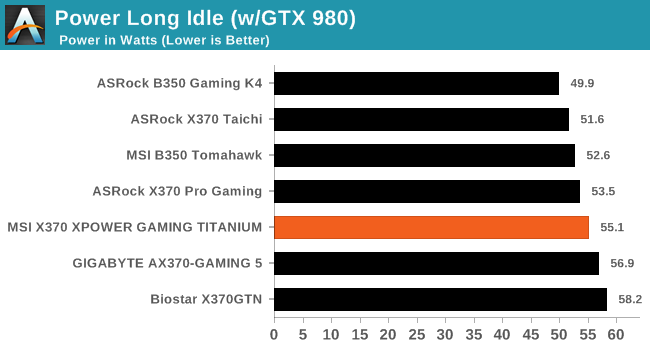
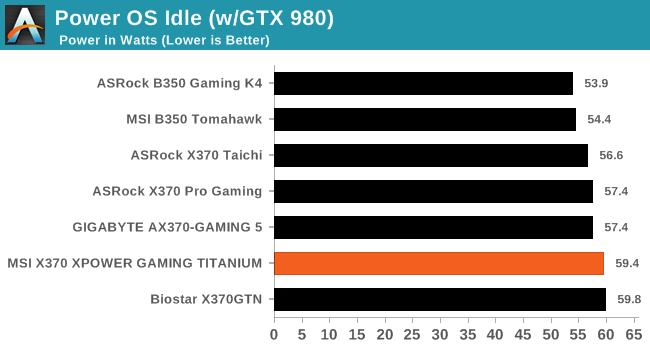
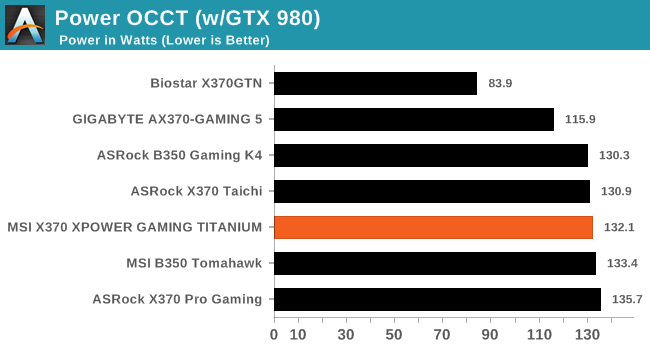
Power consumption on the XPower was around the expected levels, with it falling just below that of ASRock premium gaming motherboard under OCCT. Due to the high amount of controllers integrated onto the board and plenty of connections, the board at idle sits high among our previously tested AM4 boards.
Non-UEFI POST Time
Different motherboards have different POST sequences before an operating system is initialized. A lot of this is dependent on the board itself, and POST boot time is determined by the controllers on board (and the sequence of how those extras are organized). As part of our testing, we look at the POST Boot Time using a stopwatch. This is the time from pressing the ON button on the computer to when Windows starts loading. (We discount Windows loading as it is highly variable given Windows specific features.)
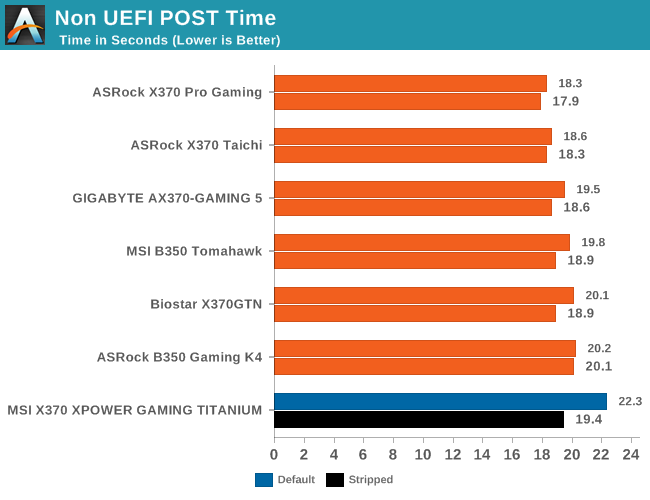
The XPower's POST time sits a couple of seconds slower when compared to the boards in the above graph, with the stripped boot being a good 3 seconds faster than with everything enabled at default.
Rightmark Audio Analyzer 6.2.5
Rightmark:AA indicates how well the sound system is built and isolated from electrical interference (either internally or externally). For this test we connect the Line Out to the Line In using a short six inch 3.5mm to 3.5mm high-quality jack, turn the OS speaker volume to 100%, and run the Rightmark default test suite at 192 kHz, 24-bit. The OS is tuned to 192 kHz/24-bit input and output, and the Line-In volume is adjusted until we have the best RMAA value in the mini-pretest. We look specifically at the Dynamic Range of the audio codec used on the rear panel of the board.
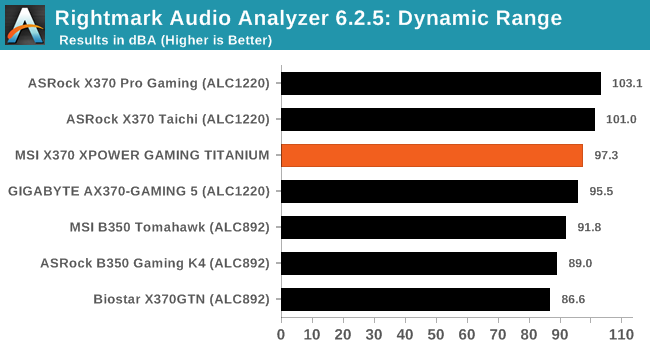
Despite the OP-AMP and audio design, it didn't really translate much in our dynamic range testing. We're still having issues testing THD+N on our AMD boards, unfortunately.
DPC Latency
Deferred Procedure Call latency is a way in which Windows handles interrupt servicing. In order to wait for a processor to acknowledge the request, the system will queue all interrupt requests by priority. Critical interrupts will be handled as soon as possible, whereas lesser priority requests such as audio will be further down the line. If the audio device requires data, it will have to wait until the request is processed before the buffer is filled.
If the device drivers of higher priority components in a system are poorly implemented, this can cause delays in request scheduling and process time. This can lead to an empty audio buffer and characteristic audible pauses, pops and clicks. The DPC latency checker measures how much time is taken processing DPCs from driver invocation. The lower the value will result in better audio transfer at smaller buffer sizes. Results are measured in microseconds.
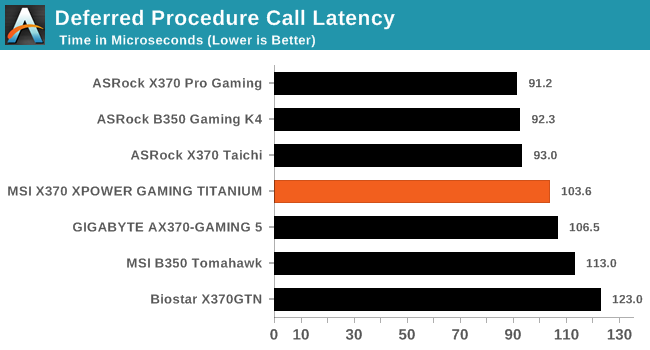
At present, none of the manufacturers of the boards tested so far have been optimized for DPC latency, but the XPower performed second best behind the ASRock boards.










19 Comments
View All Comments
Topweasel - Saturday, April 14, 2018 - link
Qasar,That is a terrible response to a little bit of critcism. If you don't want to read my criticism then don't read the comments or go back to reading PC mag or the newspaper (doesn't feel good to be told what to do because you disagree does it). I have been reading Anandtech for 20+ years now and they are by far the best site for reviews, when they review stuff. I am not criticizing them for the quality of review, I am not even really criticizing them for the time of the review though it may seem like it. All I have said is that it would behoove them to be more transparent on oddities like this series of reviews, instead of giving a bunch non-straight responses like they did at the end of page one. That it brings on and promotes speculation, some of which Ryan specifically wants to avoid because even when unfounded it's something he has been actively trying to avoid since Anandtech was sold.
I want to applaud Ryan and Ian's and the rest of the teams works over the year and while it's still not the same without Anand. It is still better than I ever could have thought it would be post losing him. But this is one point that I feel Anand would have gotten right. He would be as straight a shooter as possible even if it ruffled a few feathers.
Reflex - Sunday, April 15, 2018 - link
I suppose you could apply for a full refund...philehidiot - Monday, April 16, 2018 - link
I DEMAND my refund!stevekgoodwin - Tuesday, April 17, 2018 - link
Topweasel: "All I have said is that it would behoove them to be more transparent".You actually said this:
Topweasel: "That the secrecy behind reviewing products this late into the cycle has more to do with Purch's relationship with Intel and not down to workload."
I'm off to listen to Weasel Stomping Day. https://www.youtube.com/watch?v=k76IGLi6jWI
CrazyElf - Saturday, April 14, 2018 - link
Ian, the problem with the Nikos PowerPAK PK616BA MOSFETs are that this board is a lot more expensive than other boards that offers significantly better Mosfets - such as the X370 Taichi which is even cheaper.I mean, had this board been priced more aggressively, this would not have been an issue.
Hint: MSI - I own 2 Intel XPower boards on mainstream and on X99, an MSI X99A Godlike, I have bought 4 MSI Lightning GPUs, 2 290X Lightning and 2x 1080Ti Lightnings - but you will lose customers like me if you keep doing releasing sub-par products.
I have no issues paying a premium for a flagship - but the flagship must be worthy of a flagship title.
Koenig168 - Monday, April 16, 2018 - link
I considered this board when building a new rig back in December. Compared to the Intel versions of the Titanium, this is a mid-range board with flagship pricing and aesthetics.johnparker1 - Wednesday, April 18, 2018 - link
The problem with the Nokis Power Pak is still occurring and I am not getting any solutions related to this, I have also checked on the one website where some sort of support is available.johnparker1 - Wednesday, April 18, 2018 - link
The problem with the Nokis Power Pak is still occurring and I am not getting any solutions related to this, I have also checked on the one https://appletechsupportnumber.net/ipod-support/ where some sort of support is available.MarkJohn - Thursday, April 19, 2018 - link
Things are very open and intensely clear explanation of issues. was truly information. Your website is very beneficial. <a href="https://programmingdoc.com/assembly-language-10727... Language Assignment Help</a>